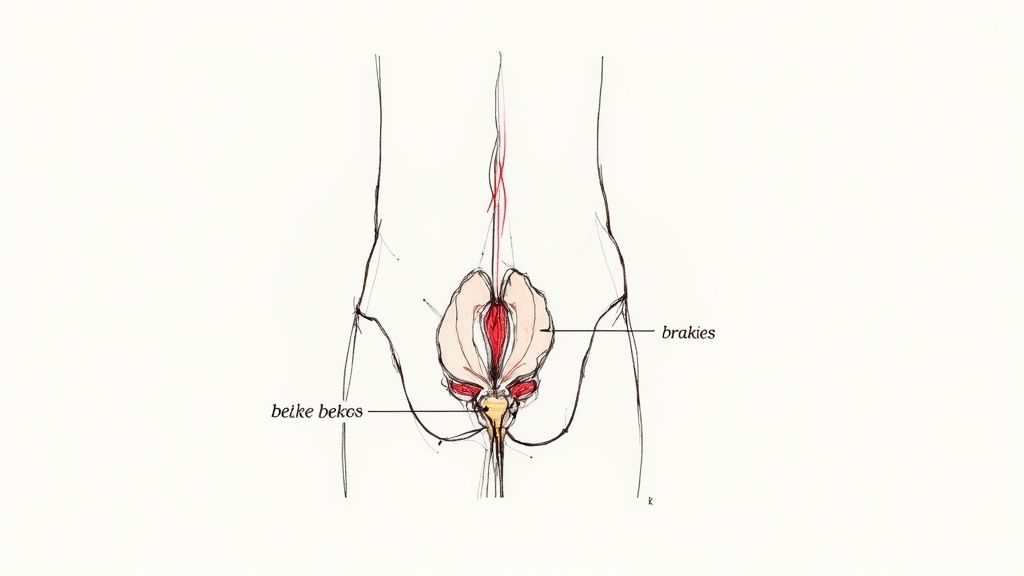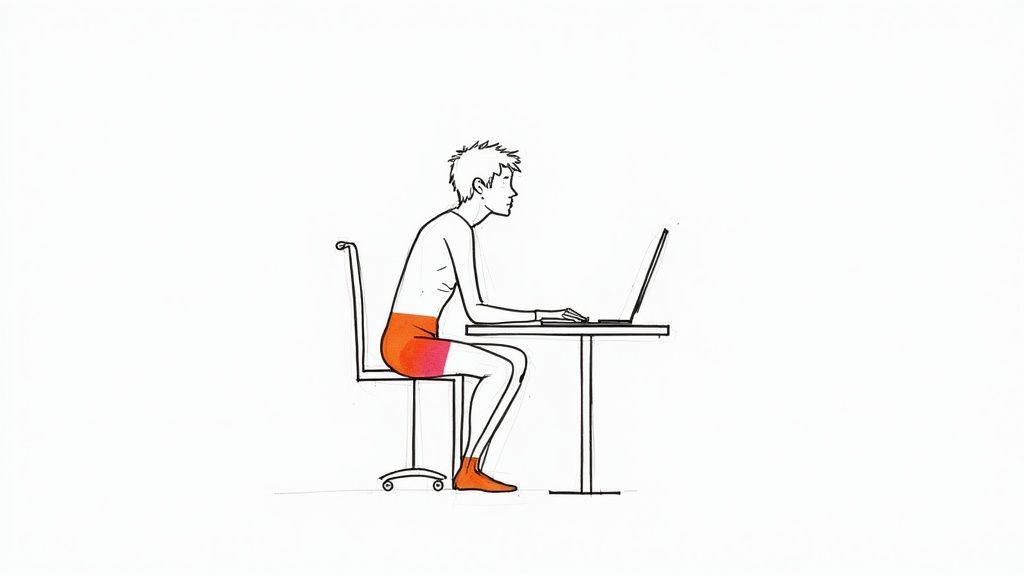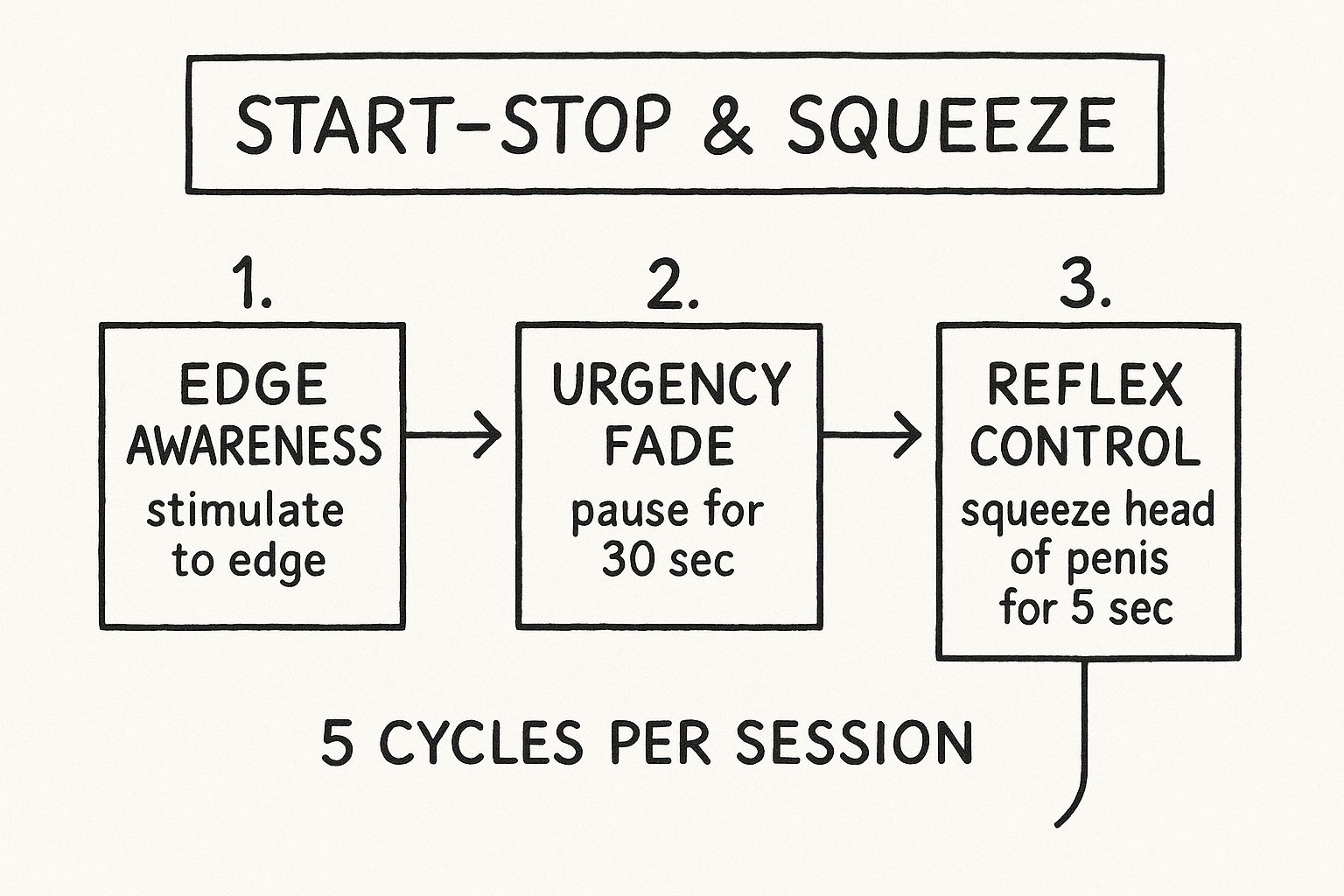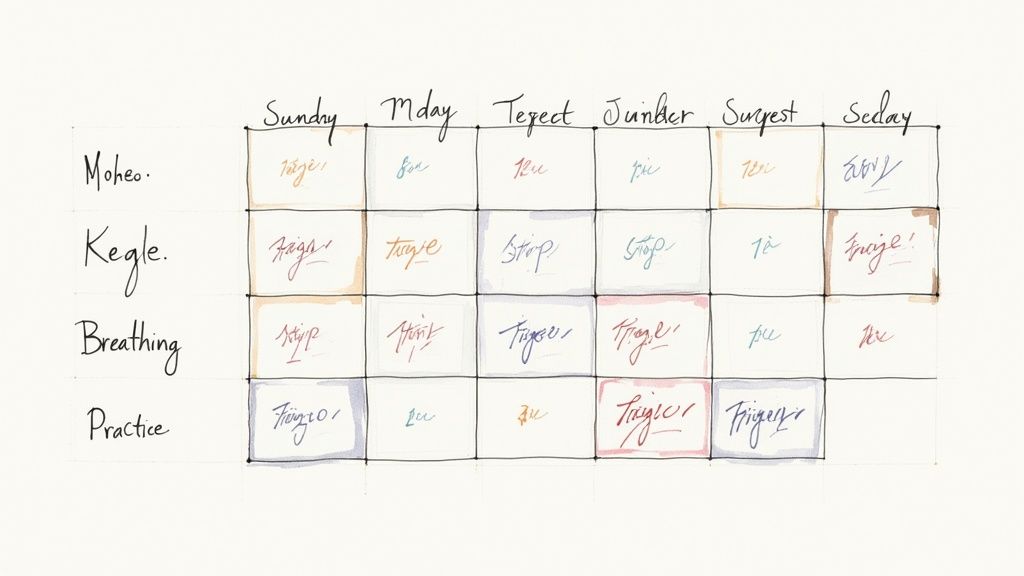Exercises to Prevent Premature Ejaculation That Work

When it comes to gaining control, the most effective exercises to prevent premature ejaculation in your arsenal are pelvic floor strengthening (Kegels), mindful breathing, and pacing techniques like the start-stop method.
Think of these as a three-pronged attack. They work together to build physical muscle control while simultaneously dialing down the performance anxiety that so often sabotages your stamina. For example, Kegels give you the physical ‘brake,’ while deep breathing calms the nervous system so you can actually apply that brake effectively. It’s a powerful, all-natural path to improving both your lasting power and your confidence.
Understanding How Ejaculatory Control Really Works

Here’s something most guys don’t realize: gaining control over ejaculation is a trainable skill. It’s not some innate talent you either have or you don’t. It’s much more like learning to lift weights or play an instrument—a physiological ability you can develop with targeted, consistent practice.
The whole secret lies in understanding your body’s natural “braking system”: your pelvic floor muscles.
These muscles create a supportive sling running from your pubic bone straight back to your tailbone, and they play a direct role in your ejaculatory reflex. When these muscles are weak or you can’t consciously engage them, you have far less command over that point of no return. But when you strengthen them, you gain a very real, very direct influence over your entire sexual response. It’s the difference between slamming on the brakes in a car versus just hoping it stops on its own.
The Foundation of Control
This guide breaks down the three core types of exercises that work in harmony to build both the physical control and the mental coolness you need. Each one tackles a different piece of the premature ejaculation puzzle.
- Pelvic Floor Strengthening (Kegels): This is the absolute cornerstone of physical control. Stronger pelvic floor muscles give you the raw ability to consciously put the brakes on ejaculation.
- Mindful Breathing: Deep, slow breathing is your key to calming the nervous system. It pulls you out of that anxious, “fight-or-flight” state that almost always triggers a quick finish.
- Pacing Techniques: Methods like the start-stop and squeeze techniques are all about learning to recognize and manage your arousal levels, keeping you from getting too close to the edge too soon.
To give you an idea of just how effective this can be, let’s look at the science. To wrap your head around what these exercises can do, here’s a quick overview of the main strategies and their benefits.
Three Core Exercise Types for Ejaculation Control
| Exercise Type | Primary Function | Key Benefit |
|---|---|---|
| Pelvic Floor (Kegels) | Strengthens the muscles that control ejaculation. | Gives you direct, physical ability to delay climax. |
| Mindful Breathing | Calms the sympathetic nervous system. | Reduces performance anxiety and the “fight-or-flight” response. |
| Pacing Techniques | Teaches arousal awareness and management. | Prevents you from accidentally crossing the “point of no return.” |
The effectiveness of these physical exercises is well-documented. A landmark 2012 clinical trial, for example, revealed that after 12 weeks of pelvic floor exercises, men dealing with lifelong PE boosted their average time from just over 30 seconds to nearly 150 seconds. An incredible 82.5% of participants gained significant control over their timing.
By mastering the “why” behind these exercises, you empower yourself to execute the “how” with greater purpose and success. It’s about building a mind-body connection that puts you back in the driver’s seat.
This guide will walk you through the exact steps to integrate these powerful techniques into your life. For a broader look at the topic, you can also explore our main category page for more information about premature ejaculation and its solutions.
Mastering Pelvic Floor Exercises for Lasting Control

Before you can strengthen a muscle, you have to know where it is. Finding your pelvic floor is the first and most crucial step, but it’s often where guys get stuck. Forget complex anatomical charts; the best way to locate these muscles is with simple, real-world cues you already understand.
Imagine you’re at a urinal and need to suddenly stop the flow of urine mid-stream. The specific muscles you clench to do that? That’s your pelvic floor. Actionable Tip: Next time you use the restroom, try this once. Stop the flow for just a second, identify the feeling, and then let it go. Don’t make a habit of it, but use it as a one-time diagnostic tool.
Another reliable trick is to imagine you’re trying to prevent yourself from passing gas. That internal tightening sensation is the exact muscle group you need to isolate.
Try it right now, wherever you are. Squeeze those muscles. You should feel a subtle lift inside your pelvis, with your testicles rising slightly. If your abs, butt, or thighs tensed up, you’re using the wrong muscles—a very common mistake.
Finding Your Focus
The secret to effective pelvic floor exercises is isolation. You have to train your brain to fire only the pelvic floor muscles without recruiting the larger, more powerful muscles surrounding them. This takes practice and some mindful attention.
To get a better feel for it, lie on your back with your knees bent and feet flat on the floor. Place one hand on your lower belly and the other under your butt. Now, try that same contraction again—the one that stops urine or gas. Your hands should feel little to no movement.
If you feel your abs crunch or your glutes tighten, just reset and try again with a bit less force. This isn’t about brute strength; it’s all about precise, focused control.
A common pitfall is holding your breath while you squeeze. Instead, make it a point to breathe out as you contract and breathe in as you relax. This rhythm stops you from tensing your entire core and keeps the focus exactly where it needs to be.
Your Beginner’s Pelvic Floor Routine
Once you can confidently isolate the right muscles, you can start building strength. Remember, consistency is far more important than intensity, especially in the beginning. Here’s a simple and effective routine to get you started.
- The Contraction: Squeeze your pelvic floor muscles and hold for a count of three seconds.
- The Relaxation: Fully release the contraction for a count of three seconds. This part is just as important as the squeeze, as it prevents the muscle from getting fatigued.
- The Repetition: One squeeze-and-release is one rep. Aim for a set of 10 to 15 reps.
Perform this simple routine three times a day. The eventual goal is to build up to holding each contraction for a full 10 seconds, but start small and focus on perfect form. Don’t get discouraged if you can only hold it for a second or two at first. That’s completely normal.
Weaving Exercises into Your Daily Life
The best thing about these exercises is how discreet they are. You can do them anywhere, anytime, without anyone knowing. The key is to make them an automatic habit, just like brushing your teeth.
Look for triggers in your daily schedule to sneak in a set:
- The Commute Cue: While stopped at a red light during your morning commute.
- The Commercial Cue: During a commercial break while you’re watching TV.
- The Inbox Cue: Every time you get an email notification at your desk.
By linking the exercises to an existing daily cue, you build the habit much faster. Over time, this conscious effort becomes an unconscious skill, giving you automatic control when you need it most.
Combining this physical training with other techniques offers a powerful, well-rounded strategy. You can explore more about the various natural ways to last longer in bed to build an approach that covers all the bases. This integration of muscle memory and mindful practice is where real, lasting change happens.
Putting the Start-Stop and Squeeze Techniques into Practice
Once you’ve started building that foundational strength with pelvic floor exercises, it’s time to bring that control into a real-world setting. The start-stop and squeeze techniques are two of the most effective exercises to prevent premature ejaculation because they get right to the heart of the issue: retraining your body’s ejaculatory reflex. They’re all about teaching you to recognize and manage the sensations leading up to that point of no return.
The secret to making these work? Start by practicing on your own. This takes all the performance pressure off the table and lets you focus completely on your body’s signals. Think of masturbation as your training ground—a place to build awareness and confidence before you bring a partner into the mix.
The Start-Stop Method Explained
At its core, the start-stop method is about becoming an expert in your own arousal patterns. The whole point is to learn exactly what it feels like to approach the edge of climax and, more importantly, how to comfortably pull back from it.
Start by stimulating yourself just like you normally would. But this time, pay close attention to your level of excitement. Your goal is to get yourself to about a 7 or 8 on a 1-to-10 scale, where 10 is the point you ejaculate. The moment you feel you’re getting close to that tipping point, stop everything. No more stimulation.
Let that urge to ejaculate fade away completely. This might take 20 to 30 seconds. Once the sensation has totally subsided, you can start stimulating yourself again and repeat the cycle. Try to run through this process four to five times in one session.
This technique isn’t just about stopping. It’s about learning to ride the waves of arousal without letting them crash. Every time you pause, you’re carving out a new neural pathway, teaching your body that high arousal doesn’t always have to end in ejaculation.
Mastering the Squeeze Technique
While the start-stop method relies on a full pause, the squeeze technique gives you a more immediate, physical way to intervene. It works by applying pressure to briefly cut off the ejaculatory reflex. A lot of guys find it really helpful to combine this with the start-stop method.
When you feel yourself getting close to that point of no return, stop stimulation and immediately use your thumb and forefinger to apply firm pressure.
- Where to Squeeze: Place your thumb on the frenulum (that little ridge on the underside of the head of your penis) and your index finger on the top side of the head.
- How to Squeeze: Squeeze firmly and consistently for about 3 to 5 seconds, or until the urge to ejaculate is gone. It should feel firm, but it shouldn’t be painful. Practical Tip: The right amount of pressure is similar to what you’d use to pinch a garden hose to stop the flow of water.
- Release and Repeat: After you let go, wait another 30 seconds or so before you start stimulation again.
This infographic breaks down how these two methods can work together in a single routine.

As you can see, it creates a repeatable training loop: build awareness, pause to let the urgency fade, and then use physical control to manage the reflex.
Ultimately, remember that these are skills. Your first few attempts might feel a bit clumsy, and that’s perfectly normal. With consistent practice, you’ll find that what once felt like an automatic reflex becomes a response you can consciously influence and control. Bringing your partner in on this can turn it into a shared goal, which helps reduce pressure even more and builds intimacy along the way.
Tame Your Nervous System with Mindful Breathing and Pacing
Physical control is only ever half the battle. Your mental game—especially how you handle anxiety and excitement—has a massive impact on how quickly you ejaculate. When you get anxious or way too stimulated, your body flips into a “fight-or-flight” state. You know the feeling: rapid heart rate, short, shallow breaths.
That physiological response puts your ejaculatory reflex on a hair trigger.
The key is to consciously shift your body out of that high-alert mode and into a calmer, more controlled state. This is where mindful breathing comes in, and frankly, it’s one of the most powerful exercises to prevent premature ejaculation you can master. It’s your body’s built-in off-switch for the nervous system.
What you need to practice is deep diaphragmatic breathing, often called “belly breathing.” It’s the complete opposite of the shallow chest breaths you take when stressed. This method uses your diaphragm to pull air deep into your lungs, which directly stimulates the vagus nerve and activates your body’s natural relaxation response.
How to Practice Deep Diaphragmatic Breathing
To get the hang of it, lie down with your knees bent. Put one hand on your chest and the other on your belly, just below your rib cage.
Now, breathe in slowly through your nose for a four-second count. Your main focus should be on making your belly rise. The hand on your chest should barely move at all.
Then, breathe out slowly through your mouth for a six-second count, feeling your belly fall. That longer exhale is the secret sauce for calming your system down. Just five minutes of this a day will build the muscle memory you need to use it instinctively during sex.
This isn’t just a relaxation gimmick; it’s a physiological reset button. Deep breathing actively lowers your heart rate and blood pressure, sending a clear signal to your brain that there’s no threat. This simple act creates the mental space you need to get back in the driver’s seat.
Pacing: Your External Control Knob
If breathing is your internal control, pacing is your external one. Pacing is all about making conscious adjustments during sex to manage your arousal level and stop it from redlining too quickly. When you pair deep breathing with smart pacing, you build a seriously effective system for lasting longer.
Here are a few practical pacing strategies you can put to use immediately:
- Change Positions: Sometimes, all it takes is a new angle. Switching to a position that offers less direct friction can instantly dial down your arousal. For instance, moving from being on top (missionary) to lying on your side (spoons) can give you that brief but crucial reset.
- Focus on Your Partner: Intentionally shift your mind away from your own sensations and put it squarely on your partner’s pleasure. Actionable Insight: Focus on watching their facial expressions or listening to their breathing. This mental pivot is surprisingly effective at stopping your arousal from spiraling out of control.
- Take a Strategic Timeout: It is 100% okay to hit the pause button for a moment. Use that time to kiss, touch, and just connect without any direct genital stimulation. This little break is your chance to take a few deep belly breaths and bring your arousal level back down from the edge.
By getting good at both breathing and pacing, you learn to manage the entire experience—mind and body. The result is a more relaxed, confident, and controlled encounter for both of you.
Building a Routine That Delivers Long-Term Results

Real, lasting control doesn’t come from a few intense training sessions. It’s built through consistency. All the exercises we’ve covered are incredibly effective, but only if they become a regular part of your routine.
Think of this as building sexual fitness—it’s a journey, not a sprint.
It’s crucial to set realistic expectations right from the start. Many guys start to feel a noticeable difference within a few weeks, but that durable, almost automatic control is built over months of steady practice. Viewing this as a long-term commitment is the real key to unlocking lifelong confidence in the bedroom.
Designing Your Weekly Training Schedule
To actually make progress, you need a plan that weaves these exercises together without feeling like a chore. The goal is to create a simple, repeatable schedule you can actually stick to.
Here’s a practical example of what that could look like:
- Daily Habit (Kegels): Aim for three sets of 10-15 Kegel contractions every single day. The easiest way to do this is to anchor the habit to something you already do. Do a set while your coffee brews, another during your commute, and a final one before bed.
- Mindfulness Practice (Breathing): Carve out just five minutes each day for deep diaphragmatic breathing. Practical Tip: Use an app like Calm or Insight Timer, or simply set a recurring daily alarm on your phone labeled “Breathe.” This can be a perfect mental reset during a stressful workday or a way to wind down in the evening.
- Practical Application (Start-Stop/Squeeze): Schedule one or two solo practice sessions per week using the start-stop and squeeze techniques. This focused time is where you really build awareness and retrain your body’s reflexes.
Remember, the goal here is progress, not perfection. If you miss a day, don’t sweat it. Just get back on track the next. Consistency over time will always beat short, intense bursts of effort.
Overcoming Common Roadblocks
Even with the best plan, you’re going to hit a few bumps. Forgetting to practice or feeling discouraged by slow progress are common hurdles for everyone. The trick is to have a strategy ready to keep you on track.
One of the best ways to stay motivated is to keep a simple journal. Just jot down a few notes after each practice session. Tracking small wins—like holding a Kegel for an extra second or successfully navigating another start-stop cycle—makes your progress tangible and keeps you in the game. To learn more about other natural methods that support this journey, check out our complete guide on how to stop premature ejaculation naturally.
It’s also worth remembering that pelvic floor training is just one piece of a bigger puzzle. A 2023 review pointed out that aerobic exercises, like running, could be as effective as some PE medications, but without the side effects.
Experts estimate that pelvic floor exercises alone can resolve PE in 55% to 83% of cases, which just shows how powerful this kind of physical training can be.
Common Questions We Hear About Ejaculation Control
Even with the best exercises in hand, you’re bound to have a few questions. That’s completely normal. Let’s tackle some of the most common ones that come up, so you can move forward with confidence and know exactly what to expect.
How Long Until I See Real Results?
This is usually the first thing men ask, and it’s a fair question. While everyone’s body responds a little differently, you’ll likely start to notice an initial improvement in your awareness and control within 2 to 4 weeks of daily, consistent practice.
But for those significant, game-changing results that stick around for the long haul? Plan on committing to these exercises for at least 3 months.
Think of it like going to the gym. You don’t build lasting muscle overnight. The most profound changes come from dedication over time, where consistency is far more important than intensity.
Is It Possible to Overdo These Exercises?
Another great question, especially when it comes to Kegels. The answer is a definite yes. Overtraining your pelvic floor can lead to muscle fatigue or even excessive tightness, which can sabotage your efforts and actually work against you.
To keep this from happening, stick to a structured routine—something like the 3 sets of 10-15 reps we recommend daily is a great benchmark. Remember, the relaxation phase between each contraction is just as crucial as the squeeze itself. If you feel any pain or discomfort, that’s your body’s signal to stop, ease up on the frequency, and give those muscles time to recover.
Here’s the key takeaway: Listen to your body. These exercises are about building coordinated strength and control, not about brute force. Pushing too hard, too fast, is the quickest way to hit a plateau.
Should I Tell My Partner What I’m Doing?
The question of involving your partner is a personal one, but it comes up a lot. While the decision is entirely up to you, bringing her into the loop can transform this from a solitary challenge into a shared journey.
- It Builds a Team: Simply sharing that you’re proactively working on lasting longer can take a huge amount of performance pressure off the table and build a much deeper sense of intimacy. For example, you could say, “I’ve been learning some techniques to help us both enjoy things more, and I’d love for us to explore them together.”
- It Makes Things Collaborative: It also makes introducing techniques like the start-stop method feel more like a fun, collaborative exploration instead of an awkward interruption during the heat of the moment.
Bringing your partner on board can be a powerful and supportive step, turning something that might cause anxiety into a genuine opportunity for connection. At the end of the day, these exercises to prevent premature ejaculation are most effective when you feel supported—both physically and emotionally.
At Fix Premature Ejaculation, we provide clear, step-by-step guidance on all these techniques and more, helping you build lasting control and confidence. Explore our full range of resources at https://ejaculationpremature.com.
Article created using Outrank